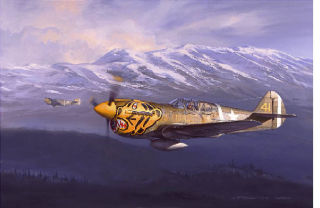Mercer Island native Jack Fellows spent most of his time in high school algebra class drawing war planes. Fifty years later, Fellows is still drawing war planes. But today he makes a living out of it.
A professional aviation artist specializing in WWII scenes over the Pacific, Fellows has published his paintings in a number of books and magazines. His work has been widely collected in the United States and abroad, with 100 postage-stamp designs under his name.
“Jack is, in my opinion, the foremost artist in the world doing Pacific WWII aviation art,” said Larry Hickey, president of the International Research & Publishing Corp.
Fellows’ work speaks for itself; detailed replications — accurate both in aircraft model and historical fact — of aviation war scenes that sell for anywhere between $100 and $1,200. A selling price in that range connotes experience, talent and hours of research.
“I make pictures of events where a photographer wasn’t there,” Fellows explained. “It takes a while to execute one of these things. You need to know the weather if you can, the geographic area, the events that happened — this all has to be parallel to the facts that were recorded historically.”
Before pulling out his paintbrush, Fellows spends hours looking through National Archives and researching historical events in the library. The artist takes no detail for granted.
“There’s a certain amount of being a journalist, being a historian and a lot of being a librarian. If you could see the place where I live — books all over the place and thousands of photographs on file,” he said with a laugh.
That place is a small house in Lake Stevens, where Fellows currently resides with his four dogs and wife, Louise. It is both his creative studio and his home.
Today, Fellows has the luxury of working for himself. After more than 10 years of painting commissioned work, he presides as art director for International Historical Research Associates, a book publisher based in Boulder, Colo. In this position, Fellows is responsible for all graphic content as well as creating illustrations himself.
“It’s kind of a dream job because these books deal with what I’ve been doing for a long time. It’s right up my alley, interest-wise,” said Fellows, who spent six years as an air crewman in the Navy Reserve.
Keeping up with modern technology, Fellows’ drawing board has been replaced with a computer. Most of the artist’s work today is created digitally in Photoshop. This new medium, however, has not changed the overall look of his illustrations, Fellows said.
“There’s very little difference in the appearance of my work from oil painting to digital tools,” he said. “Using digital tools — it’s endless what you can create. The blinding speed is the other thing. That’s what this world has turned into. You can’t be left behind.”
Fellows has been drawing and painting for most of his life. After graduating from Mercer Island High School in 1959, he enrolled at the Burnley School of Professional Art, today known as the Art Institute of Seattle, where he studied painting.
Over the next few decades, Fellows painted for local galleries — elegant portraits of North European women in folk costumes, Gypsy dancers and landscapes — while painting airplanes near Boeing Field to earn a stable income. And then one day — 21 years ago — he decided to merge his two loves: painting and aviation.
“A Seattle gallery with aviation art started showing my work. I started selling things, then I started getting commissions,” Fellows said. “I’ve always had overriding interests — art and aviation.”
The latter inspiration ran in the family.
“My dad worked for Boeing. He lived and breathed Boeing. He was one of the original people to work in the Old Red Barn,” Fellows said.
Growing up, Fellows spent much time with his father at Boeing Field, talking about aviation and building war-plane models during their free time. This connection lasted a lifetime.
“Dad’s great love was planes. He was a docent at the Museum of Flight up to several months before he died at age 93. I’d go down and meet him there, and we’d goof off. It was kinda how I got to see the old man. We shared this common interest.”
Often, Fellows’ father would help him find work.
“He was always interested in what I was doing. He knew WWII vets and would introduce me to them so I could make a picture of an event they were involved in.”
A close niche of aviation illustrators exists in America today. Between 1995 and 1997, Fellows presided as president of the American Society of Aviation Artists, which includes more than 100 members. He has also worked with aviation artists in the United Kingdom and other countries.
“There’s people all over the world who perform this function. All the various business entities involved in aerospace have people who make images for them, so there’s a big demand for work.”
At age 67, Fellows could be retired. Yet so far, he has no desire to. Drawing war planes has been a hobby of his since boyhood, and he is in no hurry to quit.
“I’ve done a lot of things in my life, but this is one thing I’ve always come back to,” the artist said. “I should be retired, but this is what I do. I love it so much I can’t imagine doing anything else.”
To view Fellows’ work, visit: www.jackfellows.com.



